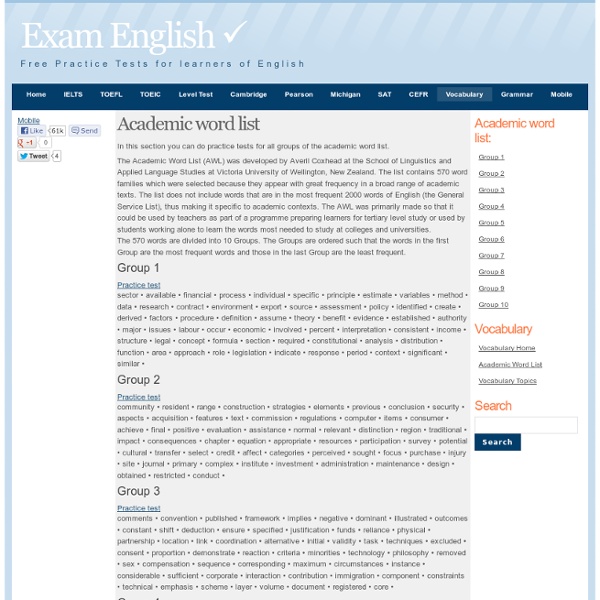IELTS Downloads
1. IELTS Speaking Topics 2. IELTS Writing Topics 3. IELTS Writing Lists 4. 5. 6. 7. 8. 9. 10. IELTS Graph-writing guide: This includes sample question, key-vocab, guided writing exercise, sample answer and teaching ideas. Download IELTS Graph-writing guide Free 11. 12. 13. 14. 15. Terms and Conditions Information published in TestPrepPractice.net is provided for informational and educational purpose alone for deserving students, researchers and academicians. Research Education Academic purposes No permission is required to link any of the web page with educational information available in this web site from your web site or web page
Practice Test
by Margaret Matthews Choose a paper. Academic reading Choose a Reading passage to download. Reading passage 1 (PDF, 217KB) Reading passage 2 (PDF, 178KB) Reading passage 3 (PDF, 210KB) Reading passage answers (PDF, 129KB) Listening Choose a Listening section to download. Listening section 1 (PDF, 208KB) | audio (MP3, 1758KB) answers and tapescript (PDF, 152KB) Listening section 2 (PDF, 202KB) | audio (MP3, 1757KB) answers and tapescript (PDF, 167KB) Listening section 3 (PDF, 130KB) | audio (MP3, 1789KB) answers and tapescript (PDF, 152KB) Listening section 4 (PDF, 130KB) | audio (MP3, 1793KB) answers and tapescript (PDF, 150KB) Speaking Parts 1,2, and 3 (PDF, 129KB) Academic writing Choose a Writing task to download.
IELTS-Blog - IELTS exam preparation for free
5 Online Calculators to Improve Your Basic Math Skills
The first “compact” calculator was released in 1957, and needed to be built into a desk. Over time the device shrank, to the point where you could easily fit it in your hand. These days most people use software calculators on their phones, instead of a separate device. This gives you a lot of choice, and different ways of using calculators. Which brings us to today’s Cool Websites and Apps, where we’ll look at five apps that do calculators differently. Of course Wolfram Alpha is a calculator and so much more, and you can also just use Google as a calculator, but knowing about more tools is always a great thing. Algebra Calculator (Web, iOS): Solves Problems, Shows Its Work There are plenty of calculators out there capable of solving algebra problems, but not all of them bother to show you how the problem was solved – which makes them useless for learning. Notepad Calculator: Jot Down Calculations, Get Answers Instantly Numi (Mac): Powerful, Attractive Calculator and Converter
The Free IELTS Academic Reading Test Lesson
The Test Format The IELTS Academic Reading Test has 3 sections. You have 60 minutes to complete the test. Marking There are 40 questions in the IELTS Academic Reading Test and 1 mark is awarded for each correct answer. IELTS Academic Reading Test Marks, Bands and Results - Rough Guide Converter IELTS Academic Reading Test Question Types Below is a list of the types of question that you could meet in the IELTS Academic Reading Test. Multiple choice questions Short answer questions Completion questions: Completing sentences Completing notes Completing a summary (no word bank) Completing a summary (with word bank) Completing a diagram Completing a flow chart Completing a table Matching a bank of headings to identify paragraphs or parts of text Matching a bank of writers' views/claims/information with the writer Identification of information in the text: yes/no/not given questions true/false/not given questions Matching lists/phrases Classification questions 17 minutes on section 1. Skimming
Career Assessment with College Majors for Career Well-Being | Career Key
YAN News - Play Your News
Statistics Problems With Solutions
One of the best ways to learn statistics is to solve practice problems. These problems test your understanding of statistics terminology and your ability to solve common statistics problems. Each problem includes a step-by-step explanation of the solution. Use the dropdown boxes to describe the type of problem you want to work on. click the Submit button to see problems and solutions. Main topic: Sub-topic: Problem description: Problem 1 In one state, 52% of the voters are Republicans, and 48% are Democrats. What is the probability that the survey will show a greater percentage of Republican voters in the second state than in the first state? Solution The correct answer is C. The solution involves four steps. Make sure the sample size is big enough to model differences with a normal population. Therefore, the probability that the survey will show a greater percentage of Republican voters in the second state than in the first state is 0.24. See also: Difference Between Proportions



